University of Dhaka: Employee Participation Report, MGT-308
VerifiedAdded on 2023/01/09
|23
|5821
|46
Report
AI Summary
This report, submitted by a group of students from the University of Dhaka, explores the concept of employee participation within the context of industrial relations. The report begins with an introduction that establishes the background, rationale, objectives, and scope of the study. It then delves into a literature review, followed by a theoretical framework that outlines various ways to improve employee participation, including participation at the board level, through ownership, collective bargaining, suggestion schemes, and job enrichment. The report also highlights the importance and advantages of employee participation, while also acknowledging potential disadvantages. The subsequent chapters present findings and analyses, leading to a conclusion and recommendations for enhancing employee participation. The report uses secondary data and employs the Harvard referencing system.

1 | P a g e
A report on
Employee Participation
A report on
Employee Participation
Paraphrase This Document
Need a fresh take? Get an instant paraphrase of this document with our AI Paraphraser
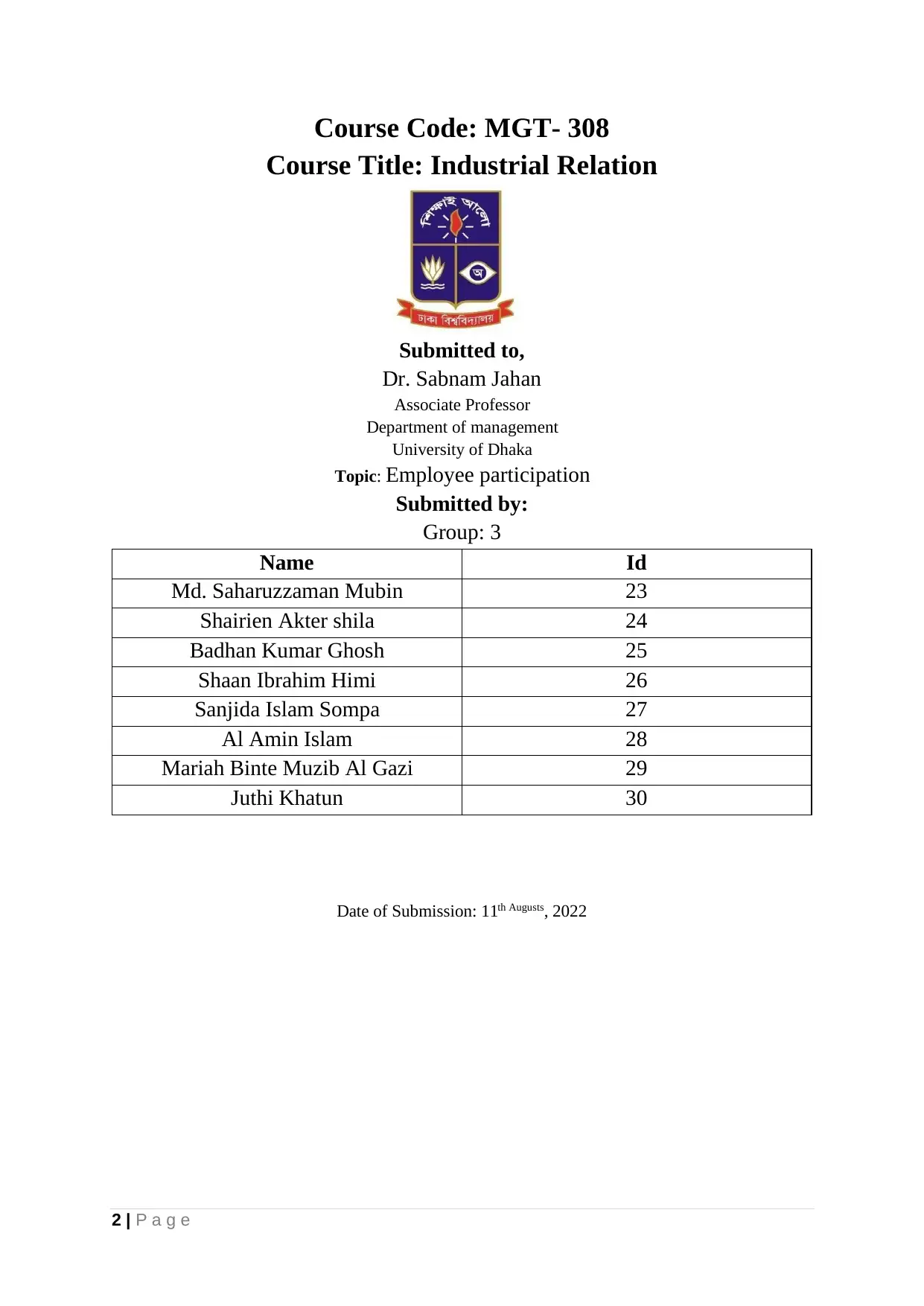
2 | P a g e
Course Code: MGT- 308
Course Title: Industrial Relation
Submitted to,
Dr. Sabnam Jahan
Associate Professor
Department of management
University of Dhaka
Topic: Employee participation
Submitted by:
Group: 3
Name Id
Md. Saharuzzaman Mubin 23
Shairien Akter shila 24
Badhan Kumar Ghosh 25
Shaan Ibrahim Himi 26
Sanjida Islam Sompa 27
Al Amin Islam 28
Mariah Binte Muzib Al Gazi 29
Juthi Khatun 30
Date of Submission: 11th Augusts, 2022
Course Code: MGT- 308
Course Title: Industrial Relation
Submitted to,
Dr. Sabnam Jahan
Associate Professor
Department of management
University of Dhaka
Topic: Employee participation
Submitted by:
Group: 3
Name Id
Md. Saharuzzaman Mubin 23
Shairien Akter shila 24
Badhan Kumar Ghosh 25
Shaan Ibrahim Himi 26
Sanjida Islam Sompa 27
Al Amin Islam 28
Mariah Binte Muzib Al Gazi 29
Juthi Khatun 30
Date of Submission: 11th Augusts, 2022
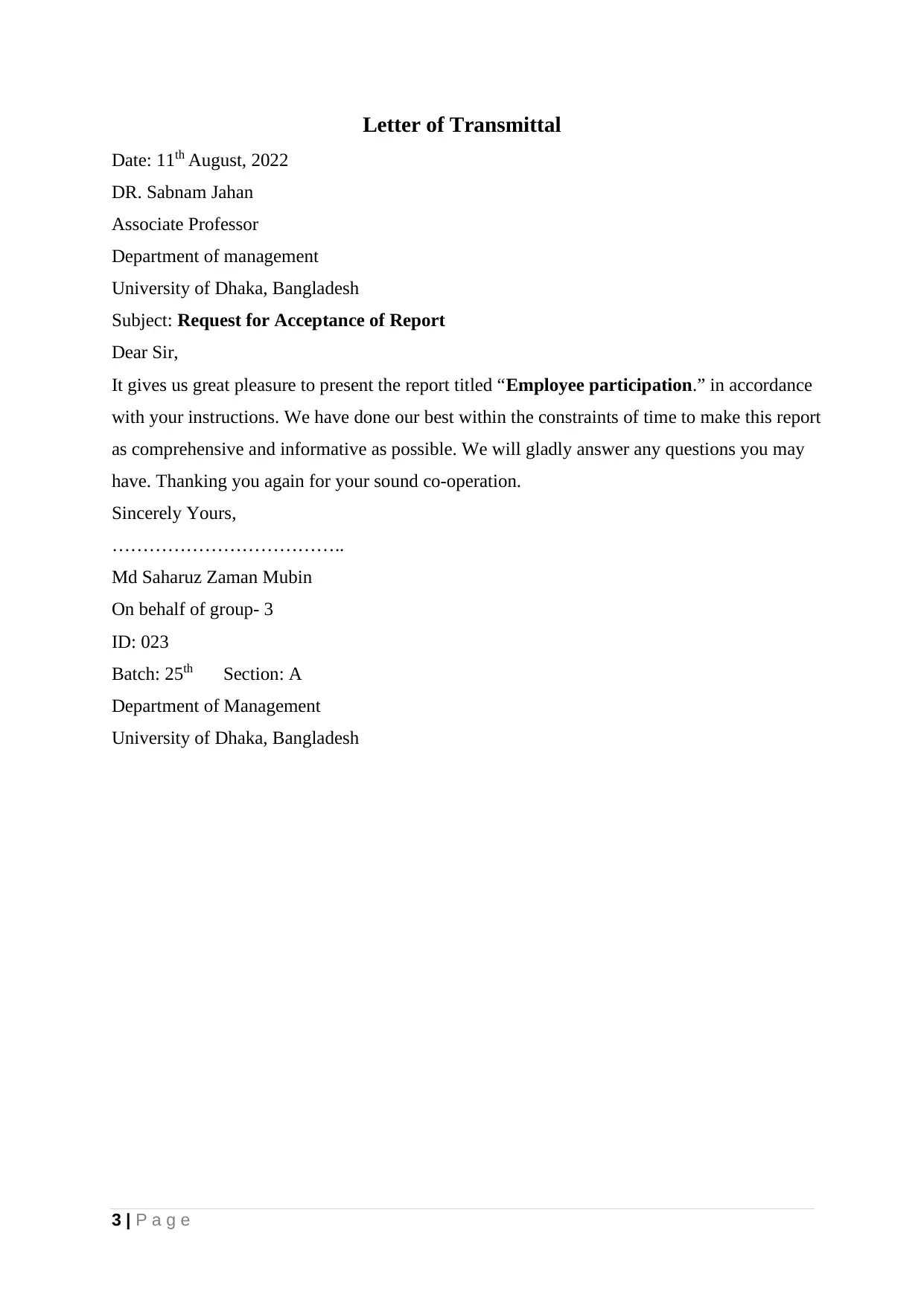
3 | P a g e
Letter of Transmittal
Date: 11th August, 2022
DR. Sabnam Jahan
Associate Professor
Department of management
University of Dhaka, Bangladesh
Subject: Request for Acceptance of Report
Dear Sir,
It gives us great pleasure to present the report titled “Employee participation.” in accordance
with your instructions. We have done our best within the constraints of time to make this report
as comprehensive and informative as possible. We will gladly answer any questions you may
have. Thanking you again for your sound co-operation.
Sincerely Yours,
………………………………..
Md Saharuz Zaman Mubin
On behalf of group- 3
ID: 023
Batch: 25th Section: A
Department of Management
University of Dhaka, Bangladesh
Letter of Transmittal
Date: 11th August, 2022
DR. Sabnam Jahan
Associate Professor
Department of management
University of Dhaka, Bangladesh
Subject: Request for Acceptance of Report
Dear Sir,
It gives us great pleasure to present the report titled “Employee participation.” in accordance
with your instructions. We have done our best within the constraints of time to make this report
as comprehensive and informative as possible. We will gladly answer any questions you may
have. Thanking you again for your sound co-operation.
Sincerely Yours,
………………………………..
Md Saharuz Zaman Mubin
On behalf of group- 3
ID: 023
Batch: 25th Section: A
Department of Management
University of Dhaka, Bangladesh
⊘ This is a preview!⊘
Do you want full access?
Subscribe today to unlock all pages.

Trusted by 1+ million students worldwide
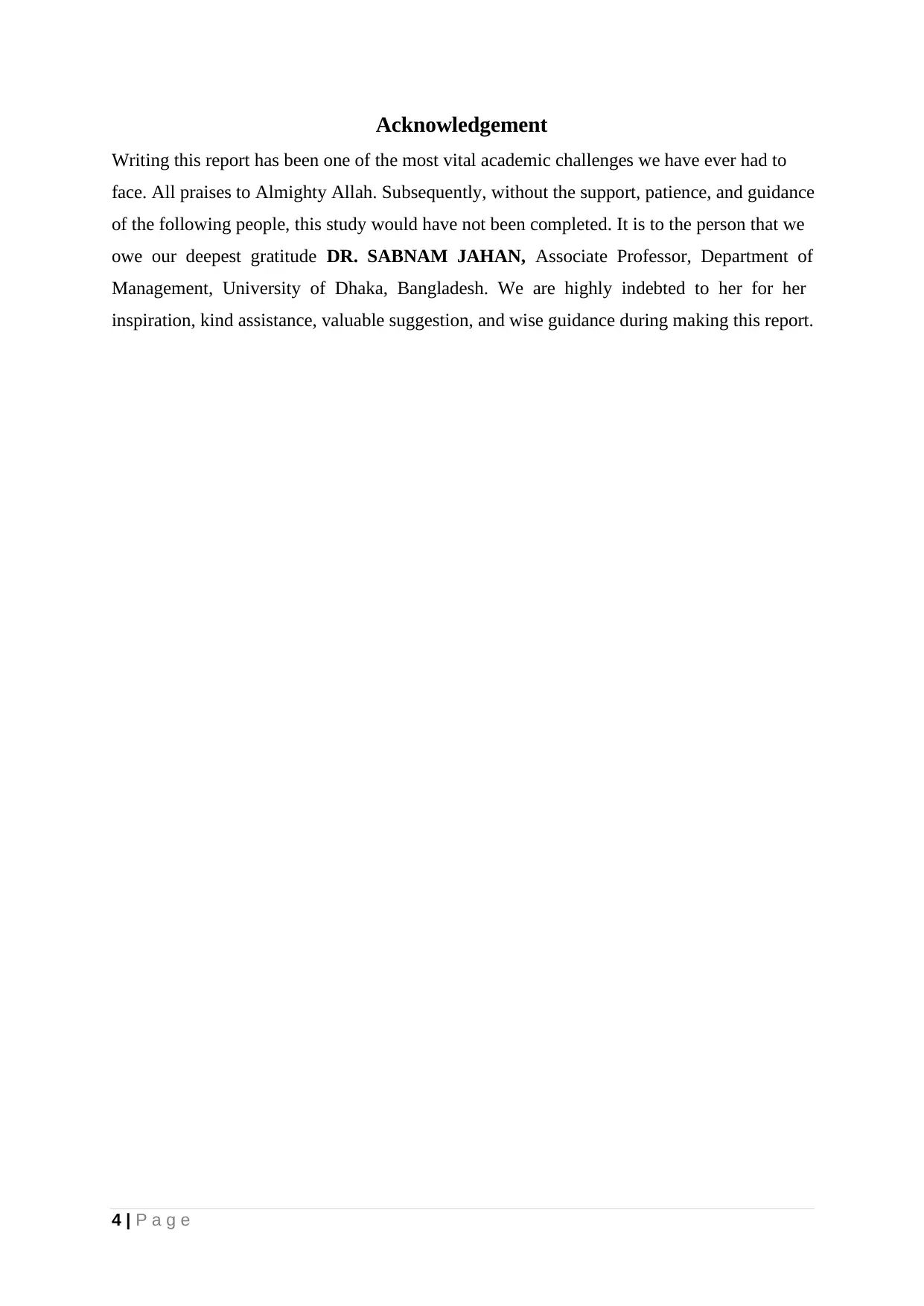
4 | P a g e
Acknowledgement
Writing this report has been one of the most vital academic challenges we have ever had to
face. All praises to Almighty Allah. Subsequently, without the support, patience, and guidance
of the following people, this study would have not been completed. It is to the person that we
owe our deepest gratitude DR. SABNAM JAHAN, Associate Professor, Department of
Management, University of Dhaka, Bangladesh. We are highly indebted to her for her
inspiration, kind assistance, valuable suggestion, and wise guidance during making this report.
Acknowledgement
Writing this report has been one of the most vital academic challenges we have ever had to
face. All praises to Almighty Allah. Subsequently, without the support, patience, and guidance
of the following people, this study would have not been completed. It is to the person that we
owe our deepest gratitude DR. SABNAM JAHAN, Associate Professor, Department of
Management, University of Dhaka, Bangladesh. We are highly indebted to her for her
inspiration, kind assistance, valuable suggestion, and wise guidance during making this report.
Paraphrase This Document
Need a fresh take? Get an instant paraphrase of this document with our AI Paraphraser
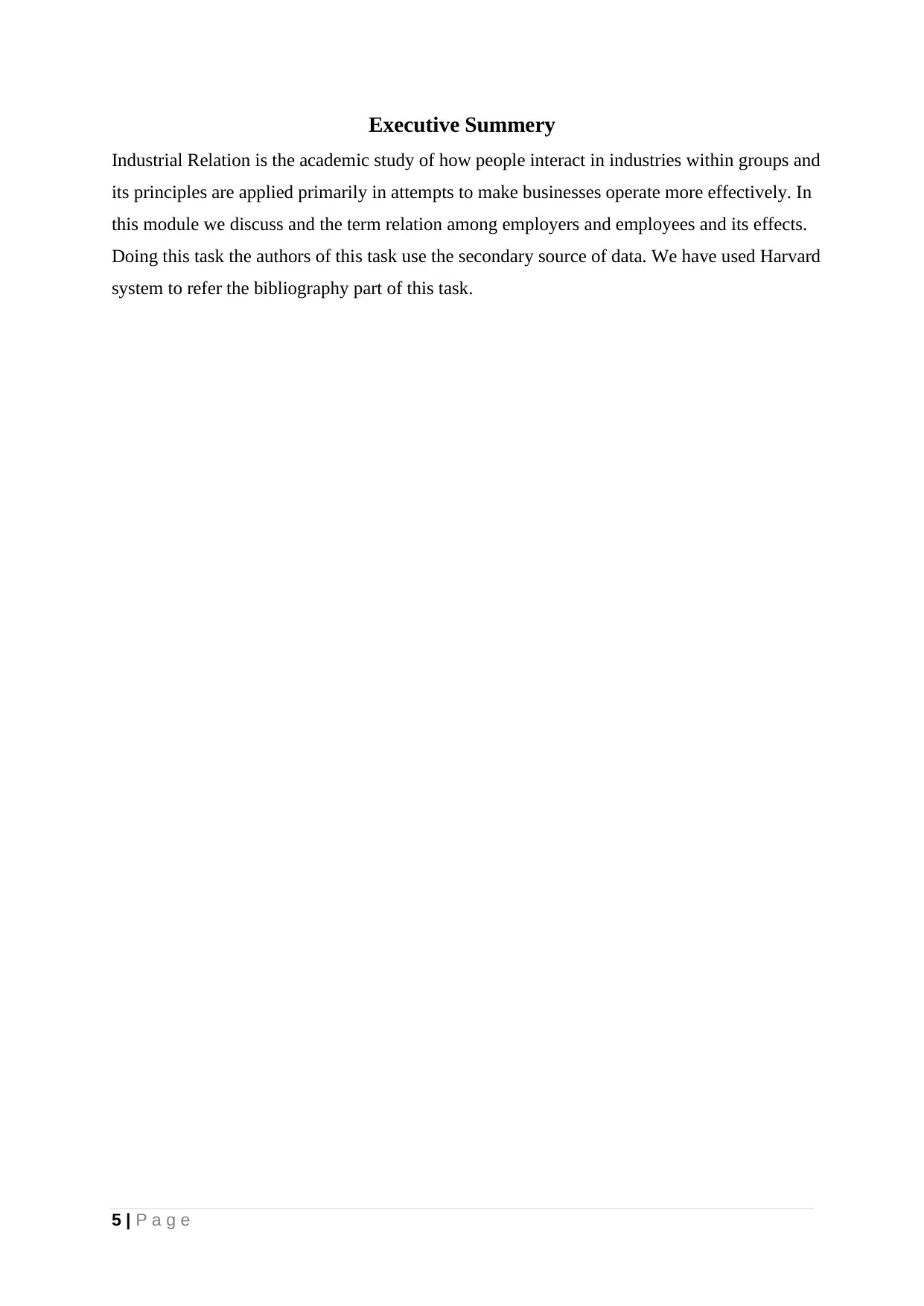
5 | P a g e
Executive Summery
Industrial Relation is the academic study of how people interact in industries within groups and
its principles are applied primarily in attempts to make businesses operate more effectively. In
this module we discuss and the term relation among employers and employees and its effects.
Doing this task the authors of this task use the secondary source of data. We have used Harvard
system to refer the bibliography part of this task.
Executive Summery
Industrial Relation is the academic study of how people interact in industries within groups and
its principles are applied primarily in attempts to make businesses operate more effectively. In
this module we discuss and the term relation among employers and employees and its effects.
Doing this task the authors of this task use the secondary source of data. We have used Harvard
system to refer the bibliography part of this task.
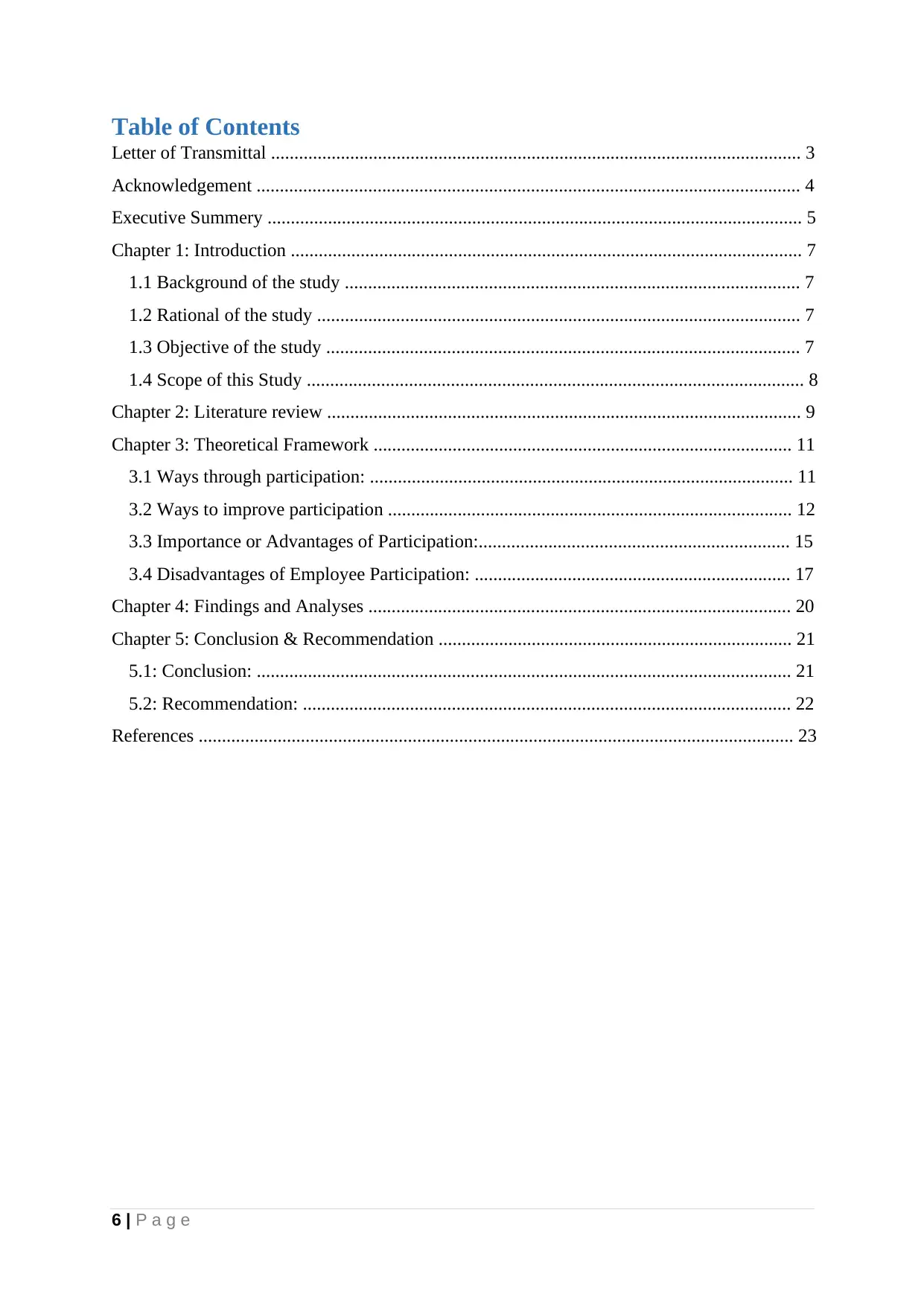
6 | P a g e
Table of Contents
Letter of Transmittal .................................................................................................................. 3
Acknowledgement ..................................................................................................................... 4
Executive Summery ................................................................................................................... 5
Chapter 1: Introduction .............................................................................................................. 7
1.1 Background of the study .................................................................................................. 7
1.2 Rational of the study ........................................................................................................ 7
1.3 Objective of the study ...................................................................................................... 7
1.4 Scope of this Study ........................................................................................................... 8
Chapter 2: Literature review ...................................................................................................... 9
Chapter 3: Theoretical Framework .......................................................................................... 11
3.1 Ways through participation: ........................................................................................... 11
3.2 Ways to improve participation ....................................................................................... 12
3.3 Importance or Advantages of Participation:................................................................... 15
3.4 Disadvantages of Employee Participation: .................................................................... 17
Chapter 4: Findings and Analyses ........................................................................................... 20
Chapter 5: Conclusion & Recommendation ............................................................................ 21
5.1: Conclusion: ................................................................................................................... 21
5.2: Recommendation: ......................................................................................................... 22
References ................................................................................................................................ 23
Table of Contents
Letter of Transmittal .................................................................................................................. 3
Acknowledgement ..................................................................................................................... 4
Executive Summery ................................................................................................................... 5
Chapter 1: Introduction .............................................................................................................. 7
1.1 Background of the study .................................................................................................. 7
1.2 Rational of the study ........................................................................................................ 7
1.3 Objective of the study ...................................................................................................... 7
1.4 Scope of this Study ........................................................................................................... 8
Chapter 2: Literature review ...................................................................................................... 9
Chapter 3: Theoretical Framework .......................................................................................... 11
3.1 Ways through participation: ........................................................................................... 11
3.2 Ways to improve participation ....................................................................................... 12
3.3 Importance or Advantages of Participation:................................................................... 15
3.4 Disadvantages of Employee Participation: .................................................................... 17
Chapter 4: Findings and Analyses ........................................................................................... 20
Chapter 5: Conclusion & Recommendation ............................................................................ 21
5.1: Conclusion: ................................................................................................................... 21
5.2: Recommendation: ......................................................................................................... 22
References ................................................................................................................................ 23
⊘ This is a preview!⊘
Do you want full access?
Subscribe today to unlock all pages.

Trusted by 1+ million students worldwide

7 | P a g e
Chapter 1: Introduction
1.1 Background of the study
Employee participation is a part of any work environment in any establishment. When you
have a group of people working under stress with different personalities, there’s bound to be a
few problems. An employee participation programme involves involving them in the decision-
making process about their workplace and the conditions under which they operate. Employees
and their bosses share the power to make decisions about their work. In addition, the level of
employee commitment to the organisation is expressed through Employee involvement.
Providing employees with a voice in the decision-making process is known as employee
involvement. Expertise of scientific or technical awareness, knowledge of the context in which
decisions are executed, history and personalities all contribute to a more informed decision-
making process when the public is involved. Better information can mean the difference
between making the right choice and making the wrong one. .We all know that when people
gather for a discussion, it is not necessary that what one thinks is right the other thinks the same
way, this difference in thinking or mentality leads to conflict.
1.2 Rational of the study
Industrial Relation is the academic study of how people interact in workplace. The principles
of the study of IR are applied primarily in attempts to make businesses operate more effectively.
The study of Industrial Relation (IR) is very interesting and challenging too. It is related to
individuals, group of people working together in teams. The study becomes more challenging
when situational factors interact. The study of industrial relation relates to the expected
behaviour of an individual in the organization. No two individuals are likely to behave in the
same manner in a particular work situation. It is the predictability of a manager about the
expected behaviour of an individual. There are no absolutes in human behaviour. It is the
human factor that is contributory to the productivity hence the study of human behaviour is
important. Great importance therefore must be attached to the study.
1.3 Objective of the study
The primary objective of this study is to develop effective group behaviour among the
employees. Increasing the amount of worker motivation through participation in management
by the workers themselves is the goal. To encourage self-expression among workers and to
make them feel as though they play an important role. To create new avenues of comprehension
that would ultimately result in enhanced productivity and harmony in one's endeavours.
Chapter 1: Introduction
1.1 Background of the study
Employee participation is a part of any work environment in any establishment. When you
have a group of people working under stress with different personalities, there’s bound to be a
few problems. An employee participation programme involves involving them in the decision-
making process about their workplace and the conditions under which they operate. Employees
and their bosses share the power to make decisions about their work. In addition, the level of
employee commitment to the organisation is expressed through Employee involvement.
Providing employees with a voice in the decision-making process is known as employee
involvement. Expertise of scientific or technical awareness, knowledge of the context in which
decisions are executed, history and personalities all contribute to a more informed decision-
making process when the public is involved. Better information can mean the difference
between making the right choice and making the wrong one. .We all know that when people
gather for a discussion, it is not necessary that what one thinks is right the other thinks the same
way, this difference in thinking or mentality leads to conflict.
1.2 Rational of the study
Industrial Relation is the academic study of how people interact in workplace. The principles
of the study of IR are applied primarily in attempts to make businesses operate more effectively.
The study of Industrial Relation (IR) is very interesting and challenging too. It is related to
individuals, group of people working together in teams. The study becomes more challenging
when situational factors interact. The study of industrial relation relates to the expected
behaviour of an individual in the organization. No two individuals are likely to behave in the
same manner in a particular work situation. It is the predictability of a manager about the
expected behaviour of an individual. There are no absolutes in human behaviour. It is the
human factor that is contributory to the productivity hence the study of human behaviour is
important. Great importance therefore must be attached to the study.
1.3 Objective of the study
The primary objective of this study is to develop effective group behaviour among the
employees. Increasing the amount of worker motivation through participation in management
by the workers themselves is the goal. To encourage self-expression among workers and to
make them feel as though they play an important role. To create new avenues of comprehension
that would ultimately result in enhanced productivity and harmony in one's endeavours.
Paraphrase This Document
Need a fresh take? Get an instant paraphrase of this document with our AI Paraphraser

8 | P a g e
1.4 Scope of this Study
Every business undergraduate student should realize that industrial relation is a crucial area
that relies on gathering knowledge under controlled settings. Organizations exist to meet
people's needs. In today's competitive environment, organizations must expand. This is
achievable when the quantity of goods produced is guaranteed to be error-free. Employee
absence and turnover reduce productivity.
Whether or whether employees are allowed to have input into the company's social, economic,
and personnel decisions is entirely contingent on the requirements of the business. However, it
is unclear how much involvement employees should have in the process of decision-making.
It is vital that all employees have a good involvement towards their jobs. They must work in a
friendly environment and achieve set goals. Managers must also foster a positive work culture.
Use of authority, delegation of power, division of labour, and effective communication.
1.4 Scope of this Study
Every business undergraduate student should realize that industrial relation is a crucial area
that relies on gathering knowledge under controlled settings. Organizations exist to meet
people's needs. In today's competitive environment, organizations must expand. This is
achievable when the quantity of goods produced is guaranteed to be error-free. Employee
absence and turnover reduce productivity.
Whether or whether employees are allowed to have input into the company's social, economic,
and personnel decisions is entirely contingent on the requirements of the business. However, it
is unclear how much involvement employees should have in the process of decision-making.
It is vital that all employees have a good involvement towards their jobs. They must work in a
friendly environment and achieve set goals. Managers must also foster a positive work culture.
Use of authority, delegation of power, division of labour, and effective communication.
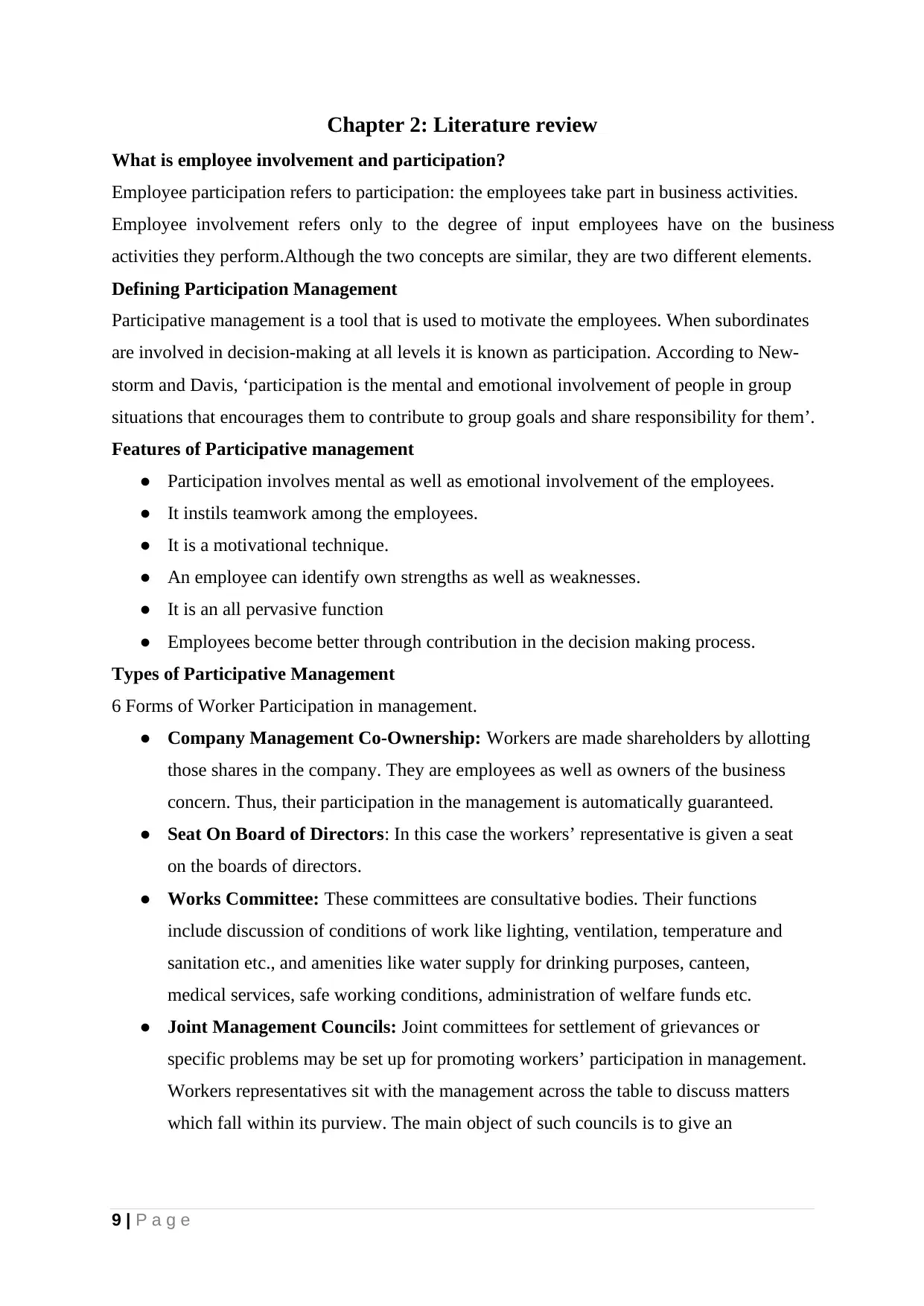
9 | P a g e
Chapter 2: Literature review
What is employee involvement and participation?
Employee participation refers to participation: the employees take part in business activities.
Employee involvement refers only to the degree of input employees have on the business
activities they perform.Although the two concepts are similar, they are two different elements.
Defining Participation Management
Participative management is a tool that is used to motivate the employees. When subordinates
are involved in decision-making at all levels it is known as participation. According to New-
storm and Davis, ‘participation is the mental and emotional involvement of people in group
situations that encourages them to contribute to group goals and share responsibility for them’.
Features of Participative management
● Participation involves mental as well as emotional involvement of the employees.
● It instils teamwork among the employees.
● It is a motivational technique.
● An employee can identify own strengths as well as weaknesses.
● It is an all pervasive function
● Employees become better through contribution in the decision making process.
Types of Participative Management
6 Forms of Worker Participation in management.
● Company Management Co-Ownership: Workers are made shareholders by allotting
those shares in the company. They are employees as well as owners of the business
concern. Thus, their participation in the management is automatically guaranteed.
● Seat On Board of Directors: In this case the workers’ representative is given a seat
on the boards of directors.
● Works Committee: These committees are consultative bodies. Their functions
include discussion of conditions of work like lighting, ventilation, temperature and
sanitation etc., and amenities like water supply for drinking purposes, canteen,
medical services, safe working conditions, administration of welfare funds etc.
● Joint Management Councils: Joint committees for settlement of grievances or
specific problems may be set up for promoting workers’ participation in management.
Workers representatives sit with the management across the table to discuss matters
which fall within its purview. The main object of such councils is to give an
Chapter 2: Literature review
What is employee involvement and participation?
Employee participation refers to participation: the employees take part in business activities.
Employee involvement refers only to the degree of input employees have on the business
activities they perform.Although the two concepts are similar, they are two different elements.
Defining Participation Management
Participative management is a tool that is used to motivate the employees. When subordinates
are involved in decision-making at all levels it is known as participation. According to New-
storm and Davis, ‘participation is the mental and emotional involvement of people in group
situations that encourages them to contribute to group goals and share responsibility for them’.
Features of Participative management
● Participation involves mental as well as emotional involvement of the employees.
● It instils teamwork among the employees.
● It is a motivational technique.
● An employee can identify own strengths as well as weaknesses.
● It is an all pervasive function
● Employees become better through contribution in the decision making process.
Types of Participative Management
6 Forms of Worker Participation in management.
● Company Management Co-Ownership: Workers are made shareholders by allotting
those shares in the company. They are employees as well as owners of the business
concern. Thus, their participation in the management is automatically guaranteed.
● Seat On Board of Directors: In this case the workers’ representative is given a seat
on the boards of directors.
● Works Committee: These committees are consultative bodies. Their functions
include discussion of conditions of work like lighting, ventilation, temperature and
sanitation etc., and amenities like water supply for drinking purposes, canteen,
medical services, safe working conditions, administration of welfare funds etc.
● Joint Management Councils: Joint committees for settlement of grievances or
specific problems may be set up for promoting workers’ participation in management.
Workers representatives sit with the management across the table to discuss matters
which fall within its purview. The main object of such councils is to give an
⊘ This is a preview!⊘
Do you want full access?
Subscribe today to unlock all pages.

Trusted by 1+ million students worldwide
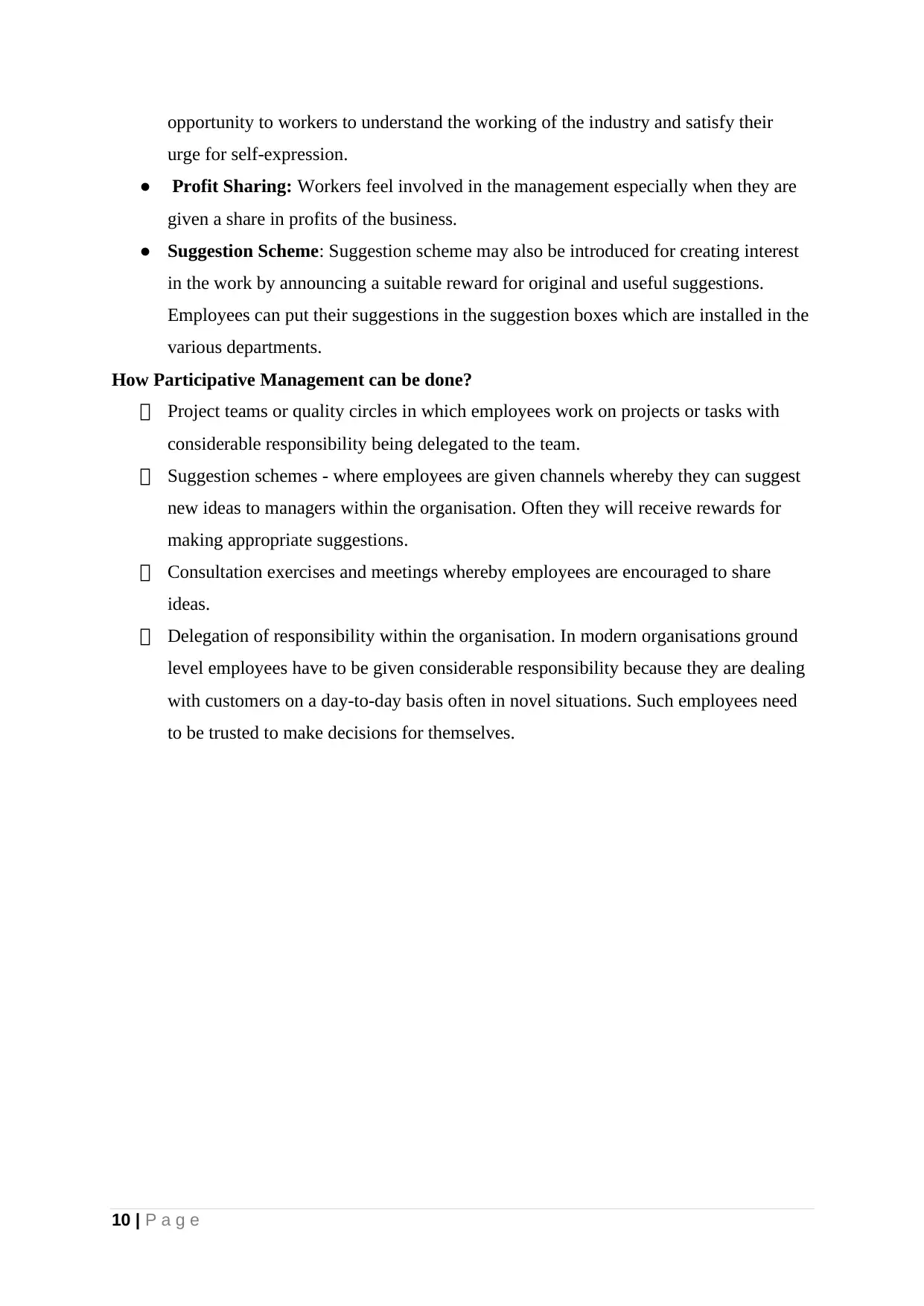
10 | P a g e
opportunity to workers to understand the working of the industry and satisfy their
urge for self-expression.
● Profit Sharing: Workers feel involved in the management especially when they are
given a share in profits of the business.
● Suggestion Scheme: Suggestion scheme may also be introduced for creating interest
in the work by announcing a suitable reward for original and useful suggestions.
Employees can put their suggestions in the suggestion boxes which are installed in the
various departments.
How Participative Management can be done?
Project teams or quality circles in which employees work on projects or tasks with
considerable responsibility being delegated to the team.
Suggestion schemes - where employees are given channels whereby they can suggest
new ideas to managers within the organisation. Often they will receive rewards for
making appropriate suggestions.
Consultation exercises and meetings whereby employees are encouraged to share
ideas.
Delegation of responsibility within the organisation. In modern organisations ground
level employees have to be given considerable responsibility because they are dealing
with customers on a day-to-day basis often in novel situations. Such employees need
to be trusted to make decisions for themselves.
opportunity to workers to understand the working of the industry and satisfy their
urge for self-expression.
● Profit Sharing: Workers feel involved in the management especially when they are
given a share in profits of the business.
● Suggestion Scheme: Suggestion scheme may also be introduced for creating interest
in the work by announcing a suitable reward for original and useful suggestions.
Employees can put their suggestions in the suggestion boxes which are installed in the
various departments.
How Participative Management can be done?
Project teams or quality circles in which employees work on projects or tasks with
considerable responsibility being delegated to the team.
Suggestion schemes - where employees are given channels whereby they can suggest
new ideas to managers within the organisation. Often they will receive rewards for
making appropriate suggestions.
Consultation exercises and meetings whereby employees are encouraged to share
ideas.
Delegation of responsibility within the organisation. In modern organisations ground
level employees have to be given considerable responsibility because they are dealing
with customers on a day-to-day basis often in novel situations. Such employees need
to be trusted to make decisions for themselves.
Paraphrase This Document
Need a fresh take? Get an instant paraphrase of this document with our AI Paraphraser
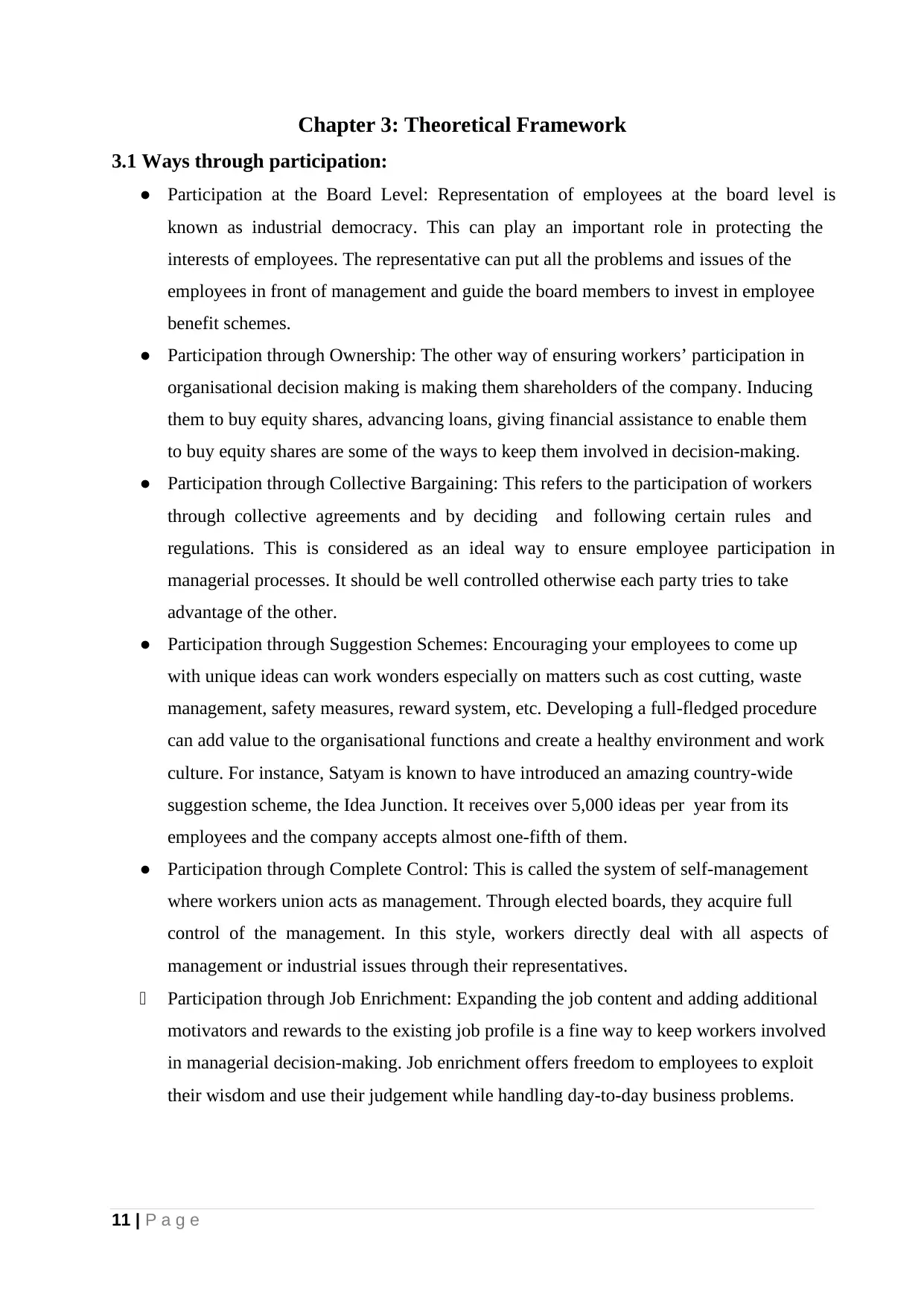
11 | P a g e
Chapter 3: Theoretical Framework
3.1 Ways through participation:
● Participation at the Board Level: Representation of employees at the board level is
known as industrial democracy. This can play an important role in protecting the
interests of employees. The representative can put all the problems and issues of the
employees in front of management and guide the board members to invest in employee
benefit schemes.
● Participation through Ownership: The other way of ensuring workers’ participation in
organisational decision making is making them shareholders of the company. Inducing
them to buy equity shares, advancing loans, giving financial assistance to enable them
to buy equity shares are some of the ways to keep them involved in decision-making.
● Participation through Collective Bargaining: This refers to the participation of workers
through collective agreements and by deciding and following certain rules and
regulations. This is considered as an ideal way to ensure employee participation in
managerial processes. It should be well controlled otherwise each party tries to take
advantage of the other.
● Participation through Suggestion Schemes: Encouraging your employees to come up
with unique ideas can work wonders especially on matters such as cost cutting, waste
management, safety measures, reward system, etc. Developing a full-fledged procedure
can add value to the organisational functions and create a healthy environment and work
culture. For instance, Satyam is known to have introduced an amazing country-wide
suggestion scheme, the Idea Junction. It receives over 5,000 ideas per year from its
employees and the company accepts almost one-fifth of them.
● Participation through Complete Control: This is called the system of self-management
where workers union acts as management. Through elected boards, they acquire full
control of the management. In this style, workers directly deal with all aspects of
management or industrial issues through their representatives.
Participation through Job Enrichment: Expanding the job content and adding additional
motivators and rewards to the existing job profile is a fine way to keep workers involved
in managerial decision-making. Job enrichment offers freedom to employees to exploit
their wisdom and use their judgement while handling day-to-day business problems.
Chapter 3: Theoretical Framework
3.1 Ways through participation:
● Participation at the Board Level: Representation of employees at the board level is
known as industrial democracy. This can play an important role in protecting the
interests of employees. The representative can put all the problems and issues of the
employees in front of management and guide the board members to invest in employee
benefit schemes.
● Participation through Ownership: The other way of ensuring workers’ participation in
organisational decision making is making them shareholders of the company. Inducing
them to buy equity shares, advancing loans, giving financial assistance to enable them
to buy equity shares are some of the ways to keep them involved in decision-making.
● Participation through Collective Bargaining: This refers to the participation of workers
through collective agreements and by deciding and following certain rules and
regulations. This is considered as an ideal way to ensure employee participation in
managerial processes. It should be well controlled otherwise each party tries to take
advantage of the other.
● Participation through Suggestion Schemes: Encouraging your employees to come up
with unique ideas can work wonders especially on matters such as cost cutting, waste
management, safety measures, reward system, etc. Developing a full-fledged procedure
can add value to the organisational functions and create a healthy environment and work
culture. For instance, Satyam is known to have introduced an amazing country-wide
suggestion scheme, the Idea Junction. It receives over 5,000 ideas per year from its
employees and the company accepts almost one-fifth of them.
● Participation through Complete Control: This is called the system of self-management
where workers union acts as management. Through elected boards, they acquire full
control of the management. In this style, workers directly deal with all aspects of
management or industrial issues through their representatives.
Participation through Job Enrichment: Expanding the job content and adding additional
motivators and rewards to the existing job profile is a fine way to keep workers involved
in managerial decision-making. Job enrichment offers freedom to employees to exploit
their wisdom and use their judgement while handling day-to-day business problems.

12 | P a g e
Participation through Quality Circles: A quality circle is a group of five to ten people
who are experts in a particular work area. They meet regularly to identify, analyse and
solve the problems arising in their area of operation. Anyone, from the organisation,
who is an expert of that particular field, can become its member. It is an ideal way to
identify the problem areas and work upon them to improve working conditions of the
organisation.
3.2 Ways to improve participation
Communicate clear goals and expectations to your employees: The majority of
employees want to be a part of a compelling future, want to know what is most
important at work and what excellence looks like. For targets to be meaningful and
effective in motivating employees, they must be tied to larger organisational ambitions.
2. Share information and numbers: Let them in on what is going on within the
company as well as how their jobs contribute to the big picture. When you keep your
employees informed they tend to feel a greater sense of worth. Keep communication
hopeful and truthful – do not be afraid to share bad news, instead be more strategic
about how you deliver it. Improve performance through transparency – By sharing
numbers with employees, you can increase employees’ sense of ownership.
3. Encourage open communication: You can get insight into what things are
important to the employee by using surveys, suggestion boxes and team meetings. Be
open-minded and encourage them to express their ideas and perspectives without
criticism. This means putting into practice everything you have learned about effective
listening. Address their concerns in the best way you can.
4. Not communicating or communicating late can damage engagement: Hearing
about an important update from the media, colleagues or family and friends can have a
negative impact on employee engagement. Ensure employees hear these messages from
the business as soon as possible.
5. Actively promote organisational effectiveness, reputation, values and ethics:
Employees want to feel good about their leaders, where they work, the products they
sell and the reputation of their company.
6. Culture: Encourage employees to find a personal fit with the company culture.
7. Let staff tell their own stories (Socialise): Encourage them to tell their own stories
about what they are doing to support company strategies or embody organisational
values.
Participation through Quality Circles: A quality circle is a group of five to ten people
who are experts in a particular work area. They meet regularly to identify, analyse and
solve the problems arising in their area of operation. Anyone, from the organisation,
who is an expert of that particular field, can become its member. It is an ideal way to
identify the problem areas and work upon them to improve working conditions of the
organisation.
3.2 Ways to improve participation
Communicate clear goals and expectations to your employees: The majority of
employees want to be a part of a compelling future, want to know what is most
important at work and what excellence looks like. For targets to be meaningful and
effective in motivating employees, they must be tied to larger organisational ambitions.
2. Share information and numbers: Let them in on what is going on within the
company as well as how their jobs contribute to the big picture. When you keep your
employees informed they tend to feel a greater sense of worth. Keep communication
hopeful and truthful – do not be afraid to share bad news, instead be more strategic
about how you deliver it. Improve performance through transparency – By sharing
numbers with employees, you can increase employees’ sense of ownership.
3. Encourage open communication: You can get insight into what things are
important to the employee by using surveys, suggestion boxes and team meetings. Be
open-minded and encourage them to express their ideas and perspectives without
criticism. This means putting into practice everything you have learned about effective
listening. Address their concerns in the best way you can.
4. Not communicating or communicating late can damage engagement: Hearing
about an important update from the media, colleagues or family and friends can have a
negative impact on employee engagement. Ensure employees hear these messages from
the business as soon as possible.
5. Actively promote organisational effectiveness, reputation, values and ethics:
Employees want to feel good about their leaders, where they work, the products they
sell and the reputation of their company.
6. Culture: Encourage employees to find a personal fit with the company culture.
7. Let staff tell their own stories (Socialise): Encourage them to tell their own stories
about what they are doing to support company strategies or embody organisational
values.
⊘ This is a preview!⊘
Do you want full access?
Subscribe today to unlock all pages.

Trusted by 1+ million students worldwide
1 out of 23
Related Documents
Your All-in-One AI-Powered Toolkit for Academic Success.
+13062052269
info@desklib.com
Available 24*7 on WhatsApp / Email
![[object Object]](/_next/static/media/star-bottom.7253800d.svg)
Unlock your academic potential
Copyright © 2020–2025 A2Z Services. All Rights Reserved. Developed and managed by ZUCOL.





